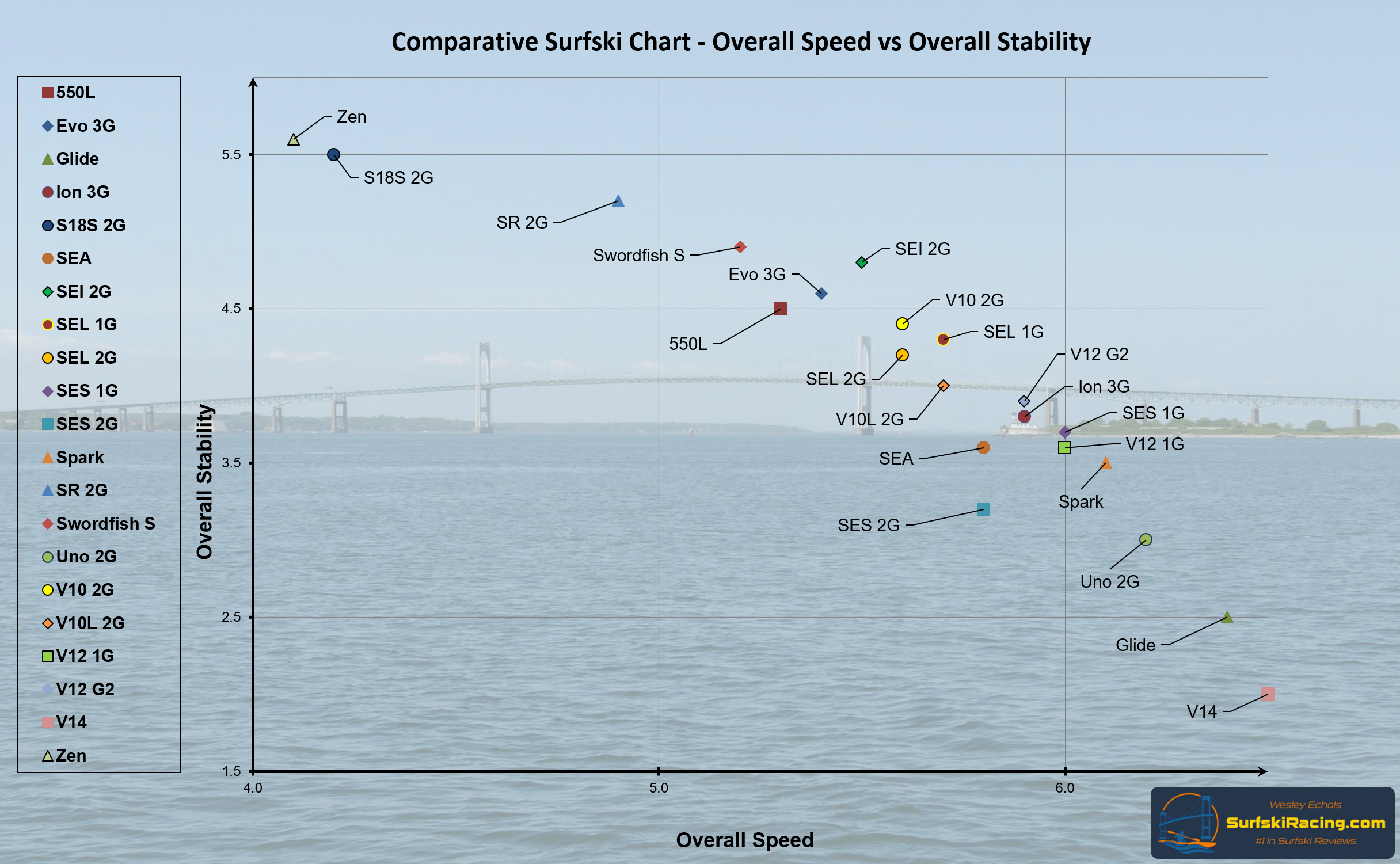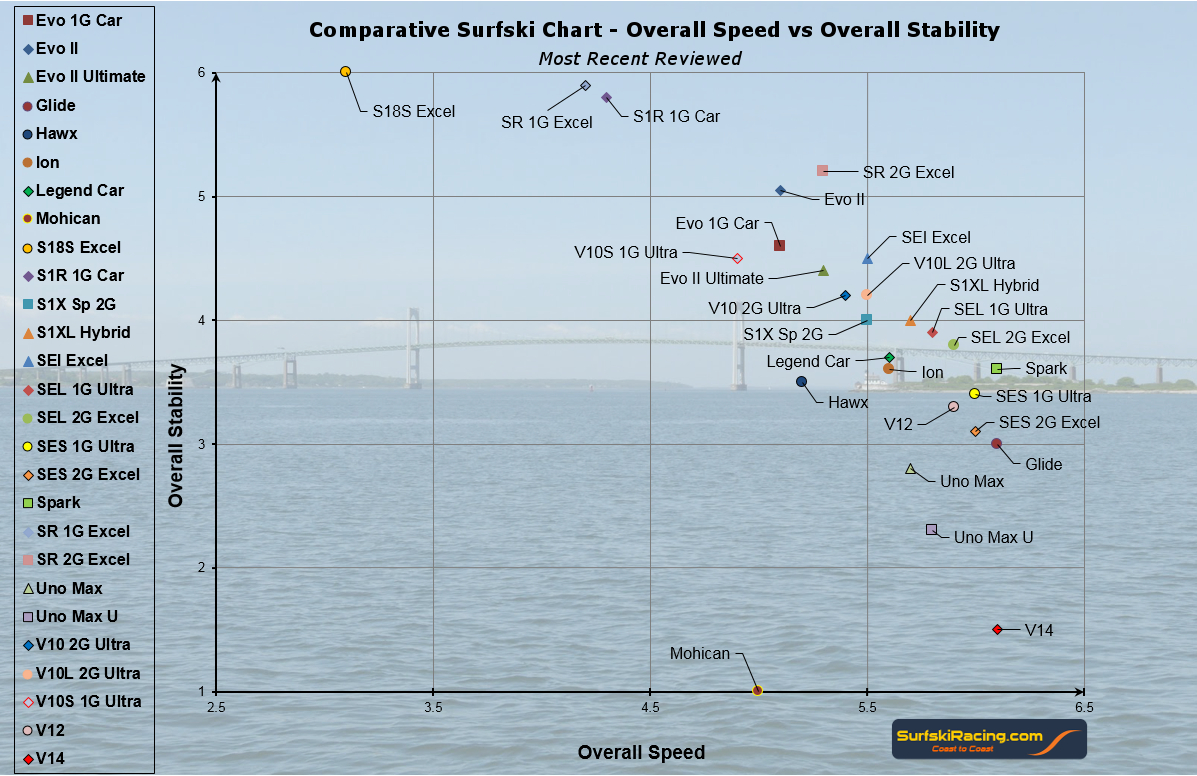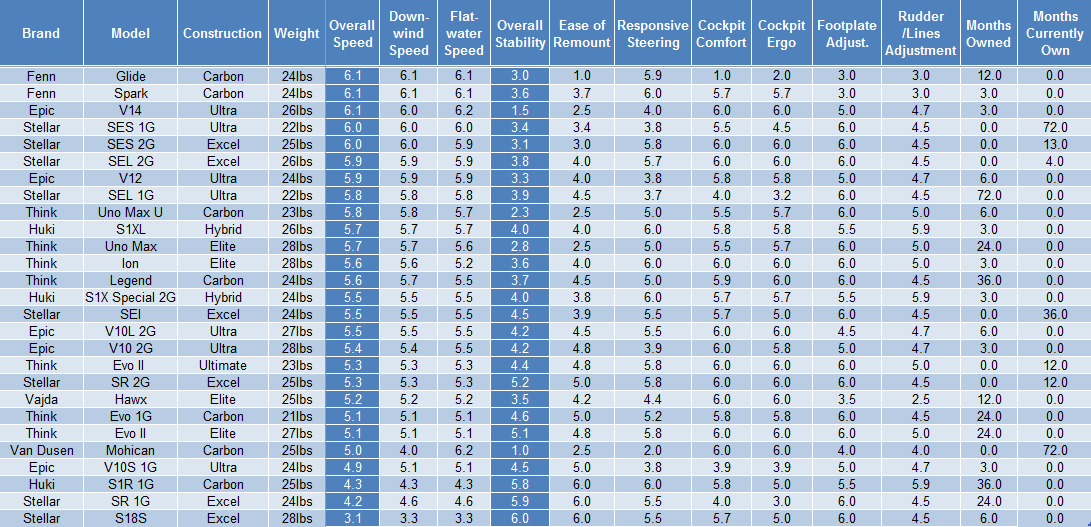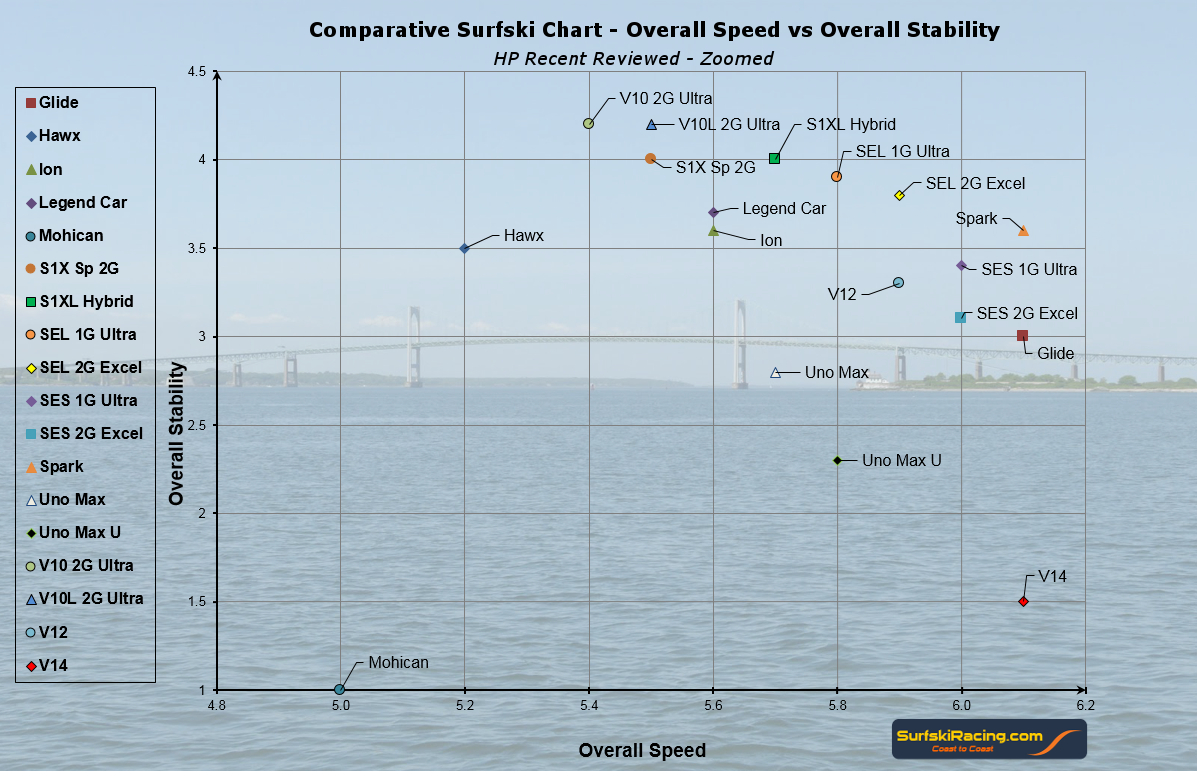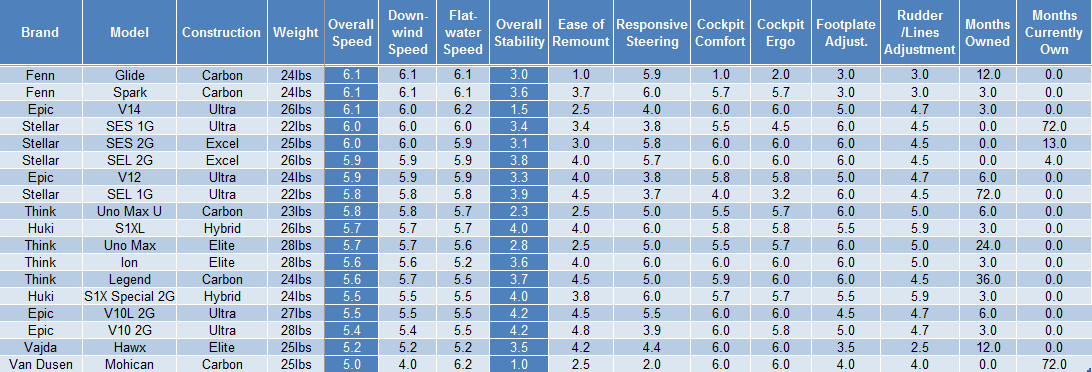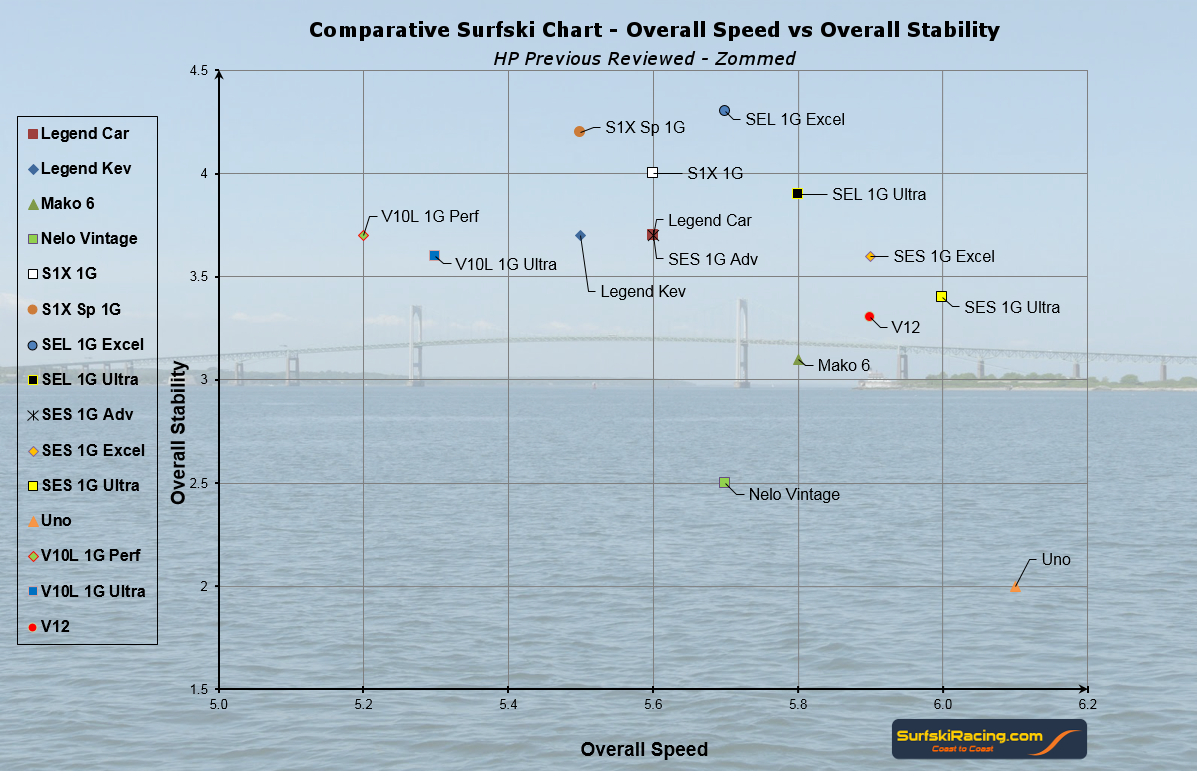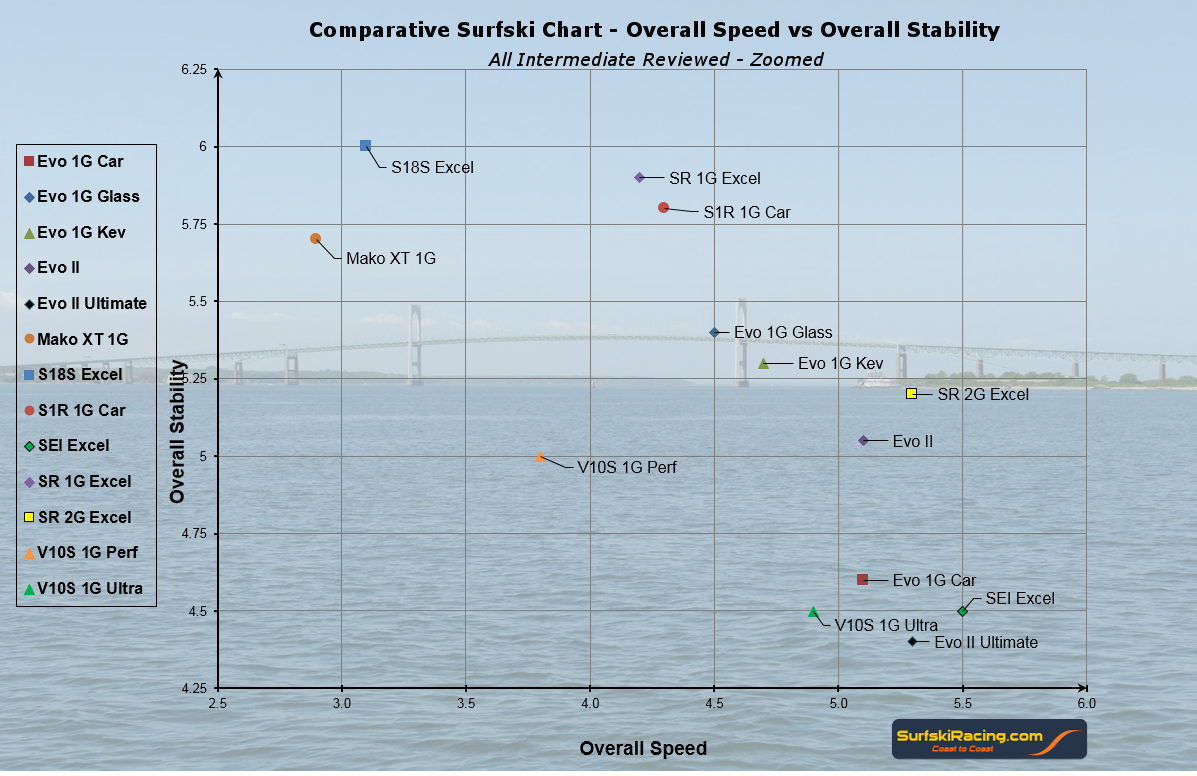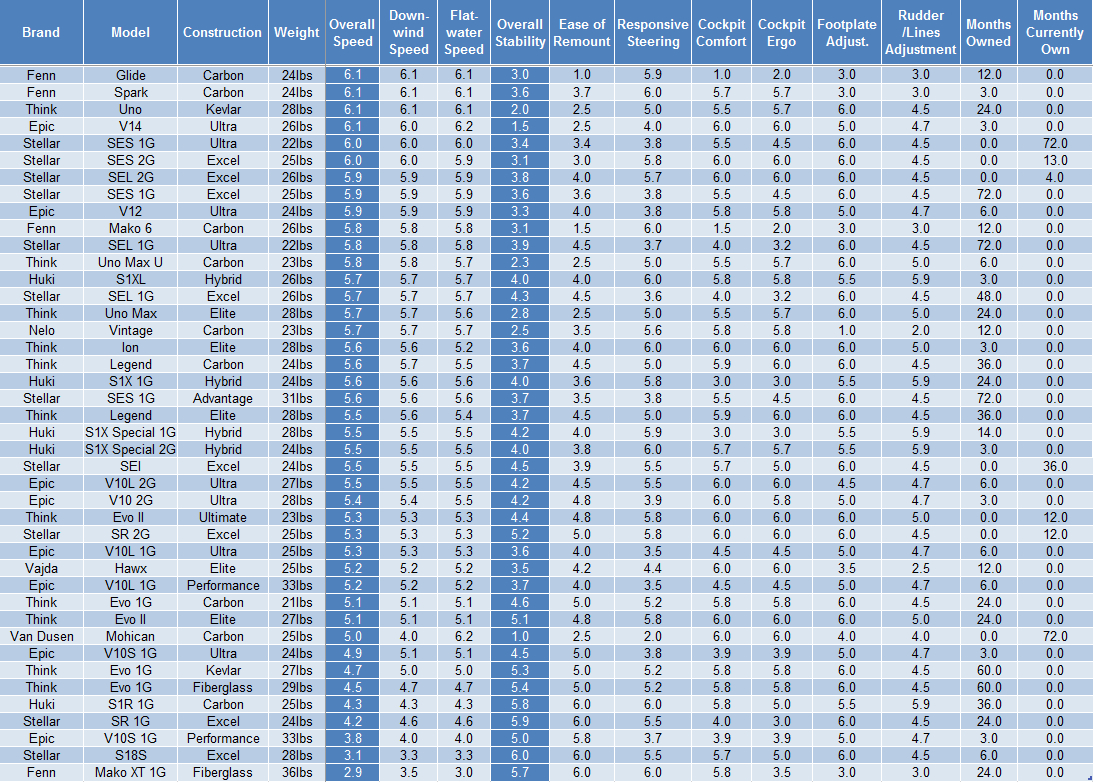2020 Surf Ski Comparison Chart-Stability/Speed Ratio-All Skis
***Charts based on conditions I paddle, train, race in.***
2020 Surf Ski Comparison Table
Reintroduction of Wesley Echols
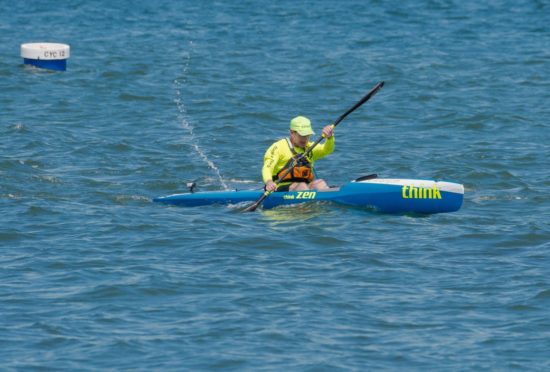
Photo Courtesy of Olga Sydorenko, 2019 Ride Bull Race on a extremely windy day in Zen on Narragansett Bay.
If you are new to this site, just a little background. I have reviewed more skis than anyone in the world, was one of the first to publish/sell a DVD on surfskis. Dawid Mocke published his in the same time frame. Most notably, I reviewed most skis after I purchased them, then preceded to paddle them over many months or years. I paddled, trained, raced, time trialed them in all New England conditions. My time trials were over the same 3 or 4 courses since 2009. So unlike a one time demo review, I put the skis through the time trials, training sessions, races and recorded my data via my Garmin GPS or my Garmin Virb video. It is not a perfect system with all the varibles, but I tried very hard to provide useful information to the paddlers. If you emailed me, phoned me or took a lesson from me over the years, I gave you even more information on what surfski is appropiate for you regardless of brand. I published this info and race summaries on this website since 2010. To my knowledge I was the first to do this in such a public and systematic fashion. See more of the details in my 2016 Surfski Chart on this page.
How to Intepret the 2020 Chart and Tables
Remember as I paddle, train, race more skis, each perspective ski’s data points changes in relation to the newer skis or in relationships to the older skis. The data point is plotted based on the numbers I gave each ski based on the Stability and the Speed. The combination is the data point. So the highest rated ski would be in the top/right section of the graph. So the V14 at the bottom right is the fastest ski but not very stable, while the Zen is one of the most stable but not fast in comparison to the V14. If you look at the SEI 2G and Evo 3G both are comparable in speed however, the SEI 2G is more stable hence the different data point. Remember also that there is a huge difference between a 5.9 speed rated ski like the Ion 3G and a 5.3 rated speed ski like the Nelo 550 1G. Night and Day. Refer back to my specific written reviews on each individual ski for more info. The table is sorted on the overall speed column though I can sort on any column in my data base.
I have reviewed/owned other skis since 2016 that I chose not to include on the chart like the Nelo 560ML. I only use this ski for pure flat water so reviewing it for ocean paddling is not fair. The seat is slightly too narrow for me in the ocean which is an example of a proper fit is key. Too narrow a bucket exaggerates the instability of skis. I also owned the Uno Max 3G but due to my difficulty in remounting it in conditions, I only paddled it in primarly in flat water for safety reasons.
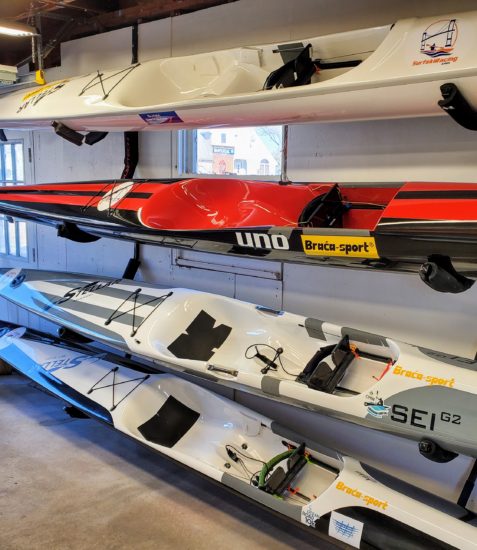
March 2020 Garage Left side
Also the difference between the novice, intermediate, advanced skis is huge. Lastly, my reviews are biased towards ocean paddling not flat water. Most intermediate paddlers can paddle an advanced ski on pure flat water with some practice. Many flat water paddlers believe since they have mastered an advanced ski on flatwater they can now paddle it in the bay, or ocean. They let their male ego get in the way. They find out very quickly it is not going to happen. Buy the ski that is appropiate to where you train 90% of the time. For many of us that race flat water and ocean, that means buying a flat water ski and a more stable ocean ski. So I race my Uno 2G Ultimate for the pure flat water races and then I race my intermediate skis for bigger conditions. There was a time I when I was younger, I could race the advanced skis(SES 1G, V12 1G, in all conditions but now I pick and choose a ski based on the conditions since I am older now.
So the chart is relative.
I deleted many of the first generations skis (1g) and the different layups of the same ski. I left a few on the chart for comparison sake. I often have different layups of skis, so for this 2020 chart, I only rated the lightest layup that I reviewed. Word of caution, lighter skis are noticably less stable in ocean paddling than a heavier layup in the same model. I left the SEL 1G, SES 1G, V12 1G, S18S 1G on this chart for comparison purposes. I also still own an SEL 1G that I race.
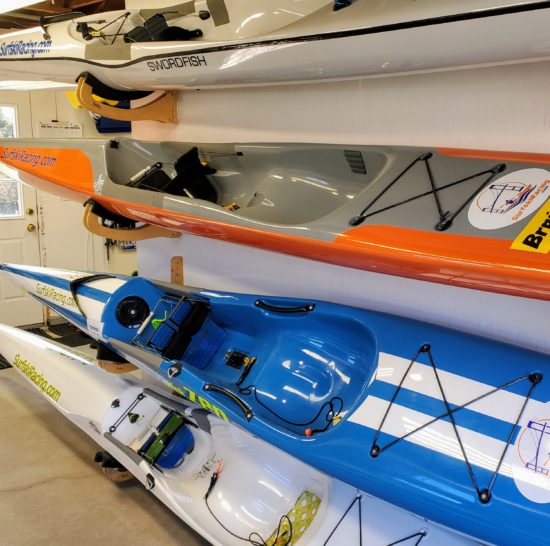
Garage March 2020 Right side
I also deleted the Van Dusen Mohican since it is limited to pure flat water. It still rates a touch behind the V14 while being more stable. Mohicans are no longer made.
I deleted a few of the columns like the steering, ergonomics of bucket, how long owned, etc, to clean up the table. These elements are very important but most paddlers really want to know speed/stability though FIT is the #1 Factor consideration when buying a ski along with a few other factors. This fit factor is very personal and specific to that person. Steering varies from ski to ski though not as much separation as in years past with few exceptions like the highly rockered skis and the cabled skis. I personally like skis that steer with minimal rudder input.

Basement March 2020
In the past four years since I posted my 2016 Comparison Chart(see below), on average, within the different classes of skis: Novice, Intermediate, Advanced, the boats are becoming more similiar with some exceptions. Kind of like all the SUV class of cars on the market now. Do you like the Surbaru Forrest, Honda CRV, Toyota Rav 4 or the Hyundai Sante Fe? All different with pros and cons but all excellent SUV’s at comparable price points and within the same category. So if the data points look less spaced out in 2020, then this is the reason. Cars are getting better and so are the skis. There is ski for everyone! Yeah!
Lastly, I look forward to reviewing the Think Six and the Revo 2 in the spring or summer. If a manufacturer wants to send me a ski to review, please contact me.
2016 Surfski Comparison Chart
This 2016 Surf Ski Comparison Chart and corresponding tables are based on 14 years of paddling surf skis with GPS recorded time trials and races with all the skis listed on the charts. In 2002 I bought my first surfski (Mako XT) and three months later, I bought my Huki S1X and so my quest for the perfect ski began.Thanks to Chris Chappell for expertly formatting all my charts and tables since we started the website in 2009.
Conditions where I review the surfskis
Portsmouth, Rhode Island is a perfect place not only to paddle surf skis, but to review skis, since I have access to many different types of water from flat, to bay, to ocean, all within minutes of my house. I paddle primarily on the Sakonnet River, Narragansett Bay, Rhode Island Sound and race the majority of the races in New England. My four main measured time trial courses are my 3.2 mile course, 6.4 mile course, 11.6 mile course (Sakonnet River Race), and 6 mile course, which are all on different segments of the Sakonett River with some over lap.
The Sakonnet River is a misnomer. It really is a 2-3 mile wide channel stretching 11 miles while getting wider and wider as it opens into Rhode Island Sound. On the other end, it narrows to one mile across as it connects to Mount Hope Bay. Different sections of the Sakonnet offer varying conditions from flat to refractory waves, to some excellent 1-3 ft nicely formed waves. Since 2003 I have also raced and paddled with the same group of New England racers and training partners and can chart my race times compared to them in the various skis. This offers another excellent point of reference beside the GPS time trial data. Another benefit that I have over some paddlers is that I am sensitive to the nuances of skis and think about them often. Since I have anywhere from 6-10 skis in my garage at any point, I go back and forth between them on a regular basis depending on the conditions, training partners, and my energy level. I also make a point to try other skis at races that I have not tried or owned. With so many connections across the United States and the world, I often ask competent paddlers their opinion of the many skis we have in common.
My search like most of yours, is a dynamic search. Paddling and racing surf skis in ocean conditions requires competency in five key areas: balancing skills, paddling technique, cardio, strength, and ocean judgement, along with a proper fitting bucket so you can put all this together.With more bucket time, these areas improve often at different rates. So trying to match the most appropriate ski for these skill areas has been a fun pursuit. While my skill set has evolved over time, so have the surf skis. The choice of surf skis today is vastly different from 2002. Now there is a surf ski that matches your skill set, no matter where you are on the learning curve. The chart and tables helps you with that. When I started out, there was no comprehensive site that reviewed surf skis and certainly no one had compared this many skis and ranked them publicly for everyone to see. So my surfski quest has led me to review more surfskis than anyone in the world. Since 2009, SurfskiRacing.com has helped many surf ski paddlers make more informed decisions about their purchase of a surf ski(s). At least at a minimum, the site has stimulated questions paddlers should be asking themselves when purchasing a ski.
So at this point in my paddling career, I am fairly competent in the 5 key areas, balance, paddling technique, cardio, strength, and seamanship and I certainly know what a proper fitting bucket is. So for some years now, optimizing the boat(s) for my skill level for a particular race, has been a top priority for me. In other articles on this site, I have written the 12 or 13 questions you need to ask yourself when buying a ski. At the top of the list is “What is your Goal?” My goal is performing well in the races and not have too much boat anxiety about conditions. If you look at any of the race standings, my group of racers, is only separated by two minutes or less at any give race. So boat choice makes a difference when racing. Once you have maximized all the key areas of surf ski paddling or at least progressed as much as you can, based on your particular circumstances, then boat choice makes a difference.
The Skis
As a 56 year old, 5ft 9in, 178, who paddles 2-5 days a week all year around, I have owned,paddled,raced all the skis listed on the surf ski review chart for at least one month and as long as six years continuously. Like most of you reading the chart, I paid fair market value or traded for all my skis except for my Stellars and two other skis. My point is, I have made a significant time and financial investment in surfskis that is reflected by the sheer number of boats I have owned in my reviews. By the time I joined Stellar in December 2009, I had already reviewed 25 skis. There are only two skis that I borrowed to review but did not buy: a Think Ion and Chris’s Huki S1XL.
I reviewed 10 new surfskis in 2014 alone, during my one year away from Stellar Kayaks and Surfskis, all of which I previously posted in written reviews, but am just now adding them to the 2016 Surf Ski Comparison chart. The tables and corresponding chart do change over time as I review and add more boats. The table numbers reflect how surf skis compare relative to the other surfskis in the chart.
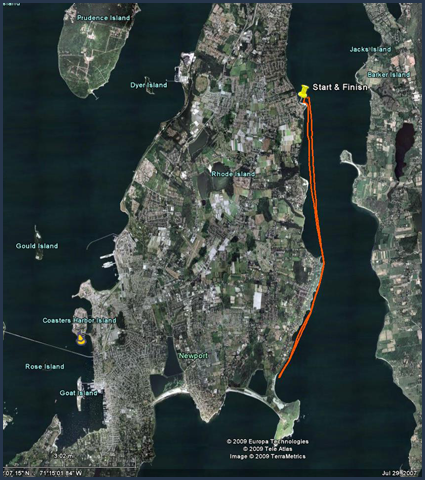
Sakonnet River. This is also the race course of the Sakonnet River Race. If you head North, that is my 6 mile flatter time trial course.
Why your experience may be different from mine.
Like any review or comparison, your experience may be different for a myriad of reasons: brand loyalty, skill level, improper fit, unavailable ocean conditions, limited point of reference, weight of your ski, your body weight, different rudders, improper technique, improper paddling position, limited time in a particular ski, just to name a few. We all have biases, and I am no different, but I have tried to minimize mine or at least disclosed them in reviewing the skis over the years.
Observations on the Chart.
I chose to rate the skis 1-6 in the different categories vice 1-10 because using 1-10 scale would magnify the differences between the boats too greatly. However, with so many skis, it very hard to tease out the differences using a small scale but there are difference and some are significant and can be profoundly significant. Where you see 1G or 2G next to some skis, that means 1st Generation or 2nd Generation of that model of ski. We sorted the data in the table based on Overall Speed and added another category Cockpit Ergonomics to go with Cockpit Comfort. Some boats may be comfortable but are not ergonomic for leg drive and technique. I also deleted the previous column Primary Stability in favor of just Overall stability.
There is one notable outlier on the chart and that is the Ted Van Dusen, Mohican. The Mohican is a nuanced ski for pure flat water paddling. If the chop or waves are over 8 inches than you are better off paddling a light weight high performance ski with a small rudder. While the Mohican is rated the same 6.2 as the V14 in flatwater, the Mohican is not designed the ocean so that brings its overall score down. The speed of the Mohican is comparable to the V14 with much,much greater initial stability but has very limited secondary stability. I included it on the chart since many paddlers asked me to include it. It remains my favorite ski for pure flat water.
When reading the chart, the preferred position of a ski is to be the farthest right on the graph and be the highest. This represents the best of both speed and stability combined in a given surfski. The numbers in the tables are reflected on the chart demonstrating the combination of Overall Stability and Overall Speed. For example the V14 is the fastest ski but is rated low on the stability axis. On the opposite end of the graph is the S18S that is the most stable but slowest of the skis on the chart.
Some skis are clearly more stable, faster, and comfortable than others. Some perform better in downwind conditions while others perform better in the flats. Having said that, over the past 6 years, surf skis have improved greatly in virtually in every facet from design, to build quality, to comfort, to better combinations of speed and stability. In viewing the chart keep in mind each paddler may place a different emphasis or weighting on each of the categories. If your goal is racing, then you obviously are looking for more speed. If you paddle primarily in ocean conditions than you may prefer a more stable ski so an emphasis is on stability vice speed. If you paddled in San Francisco you may put an emphasis on steering and stability since the water is faster and bigger than here on the East Coast. These are just a few examples.
Also pay attention to the weights of the skis within the table. The lighter the ski, the faster it is, end of story; provided you have to balance skills to paddle a lighter ski. Just as a point of reference, the difference between a ski that is rated as a 6 for overall speed and one that is rated a 5.8 is very significant, probably around 5-8 seconds per mile. So in a six mile race that could be as much as 48 seconds, the difference between first place and a fourth place finish in my races.
We are all products of the water we train in. While in New England we don’t have the swift, bigger water that they have in San Francisco, but we have a lot of chop, wind driven, messy stuff and many variations ranging from flat to 4 foot seas. My point as it relates to reviewing skis, is that most boats but not all, have the similar handling characteristics rather in 2ft seas or 4ft seas. These differences often become magnified as the conditions get bigger. For example if a particular model of ski is slow to turn in 2ft seas, then in 4ft seas it will be even slower. This a general rule of thumb. A good example of this for me was the V10L 1G ultra. It handled nicely in flat to 2ft regular seas but once the conditions became bigger and more irregular than it became noticably unpredictable and less stable.
Build Quality
Years ago I rated surfskis on quality but decided not to post those numbers. Now I feel I would be remiss if I did not generally address the build quality of surfskis. Build quality in skis is no different than build quality on cars or trucks. Few people can argue the build quality of a pre 2016 Toyota Tacoma pick up truck. They last forever and there resale value reflects this. If you are going to purchase a $2,000 to $5000.00 surfski, quality/durability does come into play. While build quality has gotten better over the last six years with all the brands, it still varies between manufacturers. So check the build quality on the different brands. Not all skis are built to the same quality standards. While I work for Stellar, the build quality on these boats is consistently excellent and have been from day one, six years ago. We are proud of our build quality and can speak openingly and willingly as to why our quality is so good from our fiberglass skis to our pre-preg carbon skis. I will let other brands speak to their their quality measures.
Summary
There is no easy, perfect way to compare skis with so many variables. That obviously has not stopped me. I am not searching for perfection, just on water, real experience, in the conditions that are available to me with my GPS, Heart Rate monitor, time trial data, training partners, race partners, races, mix conditions, and a sensitivity for the performance of skis. I have been in pharmaceutical sales for over 25 years so comparing pharmaceuticals by weighing the risk/benefits comes easy and reviewing skis is similar for me. I am also fortunate that I can fit in virtually every ski comfortably so I am not restricted by bucket size as some paddlers are.
Charts
There are 4 graphs. The first one represents 27 surfskis in all categories of skis: Novice, Intermediate, advance intermediate, and high performance skis (HPS). 27 is all we can put on one graph so we were limited for space. The second chart is the most current HPS reviewed skis, plus a few others for a reference point. The 3rd chart is the 1st Generation skis high performance skis. Finally the 4th chart are the intermediate skis.
Show Me The Data: The numbers are from July 2002 to December 2013. Obviously I have 2 more full years of data since 2013 but I had already tabulated the 2013 numbers as you can see below. I also have numerous GPS time trial data on my videos and within each review. You can see how consistent I have been over the years.
I have logged the below stats for my 4 main time trial courses, hours rounded off:
- 3.2 mile course, 174 times accumulating 408 miles in 61 hours
- 6 mile course, 154 times accumulating 871 miles in 140 hours
- 6.4 mile course, 291 times accumulating 1677 miles in 275 hours
- 11.6 mile course, 105 times accumulating 996 miles in 165 hours
